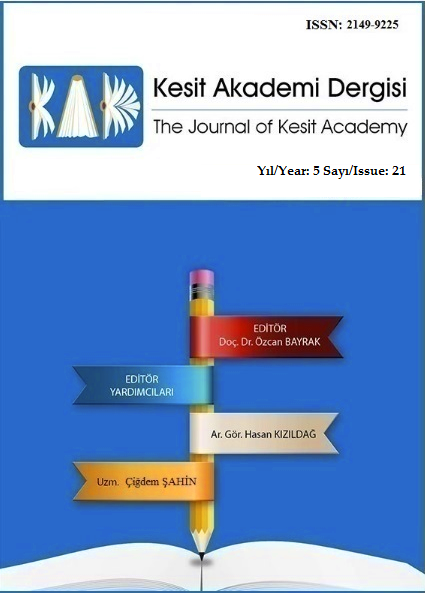MESLEK YÜKSEKOKULLARINDAKİ AKADEMİK PERSONELİN ÖRGÜTSEL ADALET ALGISININ ÖLÇÜLMESİ: ADNAN MENDERES ÜNİVERSİTESİ MESLEK YÜKSEKOKULLARI ÖRNEĞİ
Author :
Abstract
Adalet, herhangi bir olay hakkında hukuku ve kuralları gözetmek ile eşdeğer bir kavramdır. Bu kavram kişilerin sosyal hayat içerisinde bulundukları yer, konum ya da özelliklerine bakılmaksızın önem verdikleri en önemli olgulardan biri olarak karşımıza çıkmaktadır. Örgütsel adalet ise, organizasyonların ya da örgütlerin kendi içlerindeki herhangi bir olayla ilgili adaleti sağlamaları ya da gözetmeleri anlamına gelmektedir. Bu kavram kişilerin çalışma hayatındaki durumlarından, çalışma hayatına bakış açılarına dek tezahür eden bir mahiyete sahiptir. Bu çalışmada Adnan Menderes Üniversitesi bünyesinde bulunan meslek yüksekokullarında çalışan akademik personelin örgütsel adalet algılarının incelenmesi amacıyla iki bölümden oluşan anket uygulanmaktadır. İlk bölümde demografik özellikleri ölçen bir ölçek kullanılırken ikinci bölümde Niehoff ve Moorman (1993) tarafından geliştirilen “Örgütsel Adalet Ölçeği” kullanılmaktadır. Ölçek 20 sorudan oluşmakta olup, sorular 5’li likert ölçeğine göre hazırlanmıştır. Çalışma evrenini Adnan Menderes Üniversitesi bünyesinde bulunan meslek yüksekokullarında çalışan akademik personeller oluşturmaktadır. Bu bağlamda akademik personelin örgütsel adalet anlayışına bakış açıları incelenecek ve çalışmaya ilişkin sonuç ve önerilerin oluşturulması sağlanacaktır.
Keywords
Abstract
Justice is a concept equivalent to observing law and rules about any event. This concept is one of the most important facts that people give importance to regardless of their place, location or characteristics. Organizational justice means that organizations or organizations provide or respect justice for any event within themselves. This concept has a character that manifests itself in the working life perspective of the people in their working life. In this study, a questionnaire consisting of two parts is applied in order to examine the organizational justice perceptions of academic staff working in vocational high schools within Adnan Menderes University. The first part uses a scale that measures demographic characteristics and the second part uses the “Organizational Justice Scale de developed by Niehoff and Moorman (1993). The scale consists of 20 questions and the questions were prepared according to the 5-point Likert scale. The study population consists of academic staff working at the vocational schools of Adnan Menderes University. In this context, the perspectives of the academic staff on organizational justice will be examined and the results and recommendations related to the study will be provided.
Keywords
- Adams, J.S. (1965). Ineduity in social exchange. Advances in Experimental Social
- Adams, J.S. (1965). Ineduity in social exchange. Advances in Experimental Social Psychology, 2, pp.267-269.
- Beugre, Constant D., Baron, Robert A.(2001), Perceptions of Systematic Justice: The Effects ofDistrutive, Procedural, And Interactional Justice, Journal of Applied Social Psychology, 31(2), pp.324-339.
- Bies, R.J., Moag, J.F. (1986). International Justice: Communication Criteria of Faitness. In:Lewicki, R.J. Sheppard, B.H. and Bazerman, M.H., Eds, Research on Negotiations In Organizations, Vol. 1, JAI Press, Greenwich, pp.43-55.
- Cohen-Charash, Y., & Spector, P. E. (2001). The role of justice in organizations: A meta- analysis. Organizational Behavior and Human Decision Processes, 86, 278–324.
- Colquitt, J. A., Greenberg, J., & Zapata-Phelan, C. P. (2005). What is organizational justice? Ahistorical overview. In J. Greenberg & J. A. Colquitt (Eds.), The handbook of organi- zational justice (pp. 3–56). Mahwah, NJ: Erlbaum
- Cremer, DD.(2005). Procedural and distributive justice effects moderated by organizational identification, Journal of managerial psychology, 20(1), pp.4-13.
- Greenberg, J.(1990). Looking fair vs beeing fair: managing impressions oforganizational justice’, Ed. BM Staw, LL. Cummings, Research In Organizational Behaviour, Jaipress Greenweech, 12, pp.111-157.
- Greenberg, J.(1996). The quest for justice on the job: essays and experiements, Sage Publicications Inc. pp.24-57.
- Leventhal Gerald S.(1980), What Shoud Be Done With Equity Theory?, Social Exchange, Plenum Press, New York, pp.27-55.
- Niehoff, B.P., Moorman R.H.(1993). Justice as a mediator of the relationship betweenmethods of monitoring and organizational citizenship behaviour, Academy of Management Journal, 36, pp.527-556.
- Ramamoorthy, N., Flood, P.C.(2004), Gender and Employee Attirudes: The Role ofOrganizational Justice Perceptions, British Journal of Management, Vol.15, pp.247-258.





